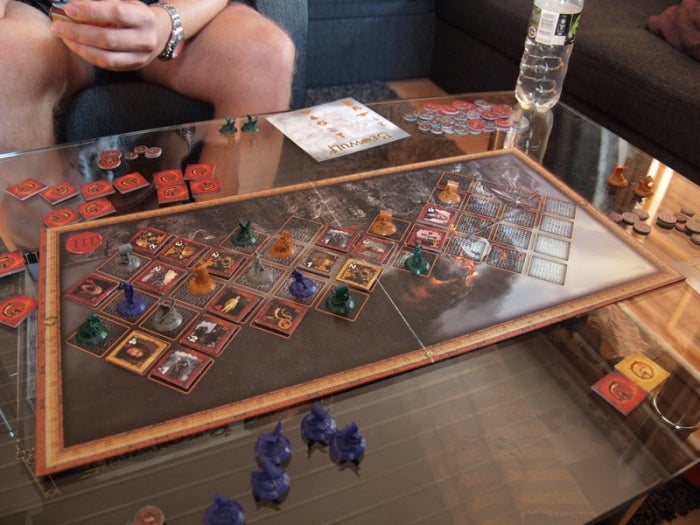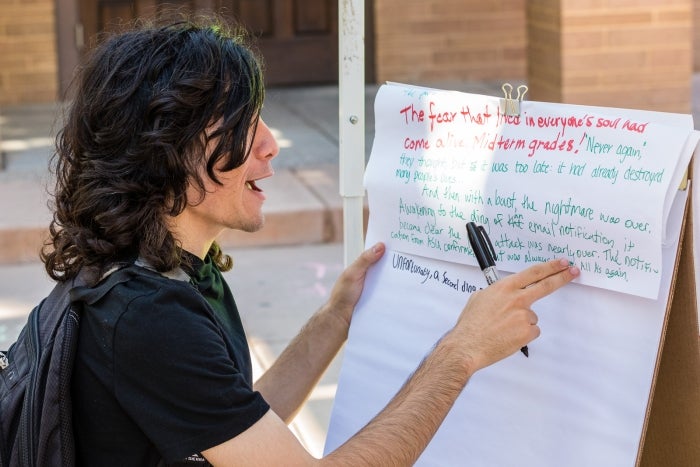6 spring ASU English classes for interpreting, creating meaning

ASU's Madeline Sayet, a clinical assistant professor of English and an affiliate of the Arizona Center for Medieval and Renaissance Studies, performs her solo show "Where We Belong" at the Goodman Theatre in Chicago. Photo by Liz Lauren
We’ve been told that so much gets lost in translation. And this is true; intention, humor and layered meanings often go by the wayside when trying to convey an idea from one language, setting, discipline, media or culture to another.
But there’s a lot to be gained in translation as well. At its essence, translation is about carrying ideas, holding space until meaning is made or understood.
Playwright and Clinical Assistant Professor of English Madeline Sayet is doing this with verve and grace in a one-woman show “Where We Belong,” currently touring the U.S. The play, also just published in book form, is an exploration of how she reconciles her interest in Shakespeare with her strong identity as a member of the Mohegan tribe. Sayet will translate her experience as an Indigenous woman in theater into the new course, ENG 350 Studies in Literary Histories and Traditions: Native American Drama this spring.
The Department of English at Arizona State University offers this and other spring 2023 courses with strategies for translating and interpreting art, culture, media, speech, gesture and writing. Registration information for a sampling of classes is provided below. Find more in the ASU class schedule (look for “ENG,” “FMS,” “LIN” or “APL” prefixes), searchable by both online and in-person options.
1. ENG 494/550: Language, Literature and Translation
What it is: Translation is a creative act that’s notoriously hard to explain; it has been compared to a bridge, a liberator, a loss, a prism, a birth, a perversion and a wave. In ENG 494/550 Language, Literature and Translation, students will ask themselves what translation is and what it means to translate. Answers to these questions will be found in writings on translation by authors from Walter Benjamin to Arthur Sze, from Jorge Luis Borges to Lydia Davis, as well as in the practice of translation itself.
Why it matters: In a culture facing global threats like climate change, humanity needs more intermediaries. A skilled translator can be one, accurately and beautifully conveying ideas and texts from one language, one culture, to another.
Who’s in charge: Assistant Professor of English Sarah Viren, a translator, nonfiction writer and New York Times contributing writer, instructs this course. Viren is author of the forthcoming memoir “To Name the Bigger Lie” (2023) and the translator from Spanish of “Córdoba Skies” (2016) by Argentenian writer Federico Falco.
Who should take it: ENG 494/550 is open to undergraduates of any major — who have met basic first-year composition requirements — and to graduate students in any program with an interest in literature, language, writers and writing, art, translation, fiction, nonfiction and poetry. While fluency in a foreign language is not necessary, students may need to work with a native speaker if they only read in English. Undergraduates should first email justin.petropoulos@asu.edu to obtain department approval to register.
If you register: ENG 494/ENG 550: Language, Literature and Translation (classes #26412 and #17318) meets Tuesdays from 4:50 to 7:35 p.m. on ASU’s Tempe campus.
2. ENG 494/531: Old English Literature
What it is: Another undergraduate-graduate-combined course planned for spring 2023 goes back further in English language history — almost as far back as that history goes. “Old English,” or Anglo-Saxon, was the lingua franca of England and parts of Scotland from about the mid-fifth to 11th centuries. In ENG 494/531: Old English Literature, students won’t be talking about “ye olde shoppes” but will focus instead on a close reading of the most famous surviving Old English text: “Beowulf.”
Why it matters: Speaking of what’s gained: the epic poem has been translated into some 30 languages from Arabic to Korean, from French to Danish, from Telugu to Turkish and been adapted into music, art, poetry, prose fiction, plays, film, television, opera, video games, comic books and graphic novels. It seems important to identify why the nearly 1,500-year-old “Beowulf” has such seemingly universal appeal.
Who’s in charge: Foundation Professor of English Robert Bjork, arguably the “Beowulf” expert, leads this course. Bjork is the co-editor of the fourth edition of “Klaeber’s Beowulf” (2008), the standard edition for students and scholars, and is general editor of the four-volume "Oxford Dictionary of the Middle Ages" (2010).
Who should take it: ENG 494/531 is open to undergraduates of any major — who have met basic first-year composition requirements — as well as to graduate students in any program with an interest in literature, language, writers and writing, art, translation, fiction, poetry, history, medievalism, battles and monsters.
If you register: ENG 494/ENG 531: Old English Literature (classes #30738 and #33931) meets Tuesdays and Thursdays from 9 to 10:15 a.m. on ASU’s Tempe campus.
3. FMS 394: Race and Digital Media
What it is: FMS 394: Race and Digital Media explores how emerging digital technologies, like social media and AI, both shape and are shaped by race and racism in the U.S.
Why it matters: From racist algorithms to optic technologies that don’t “see” darker skin, race and media are not only intertwined, but are mutually reinforcing, impacting health care, entertainment, criminal justice and everything in between.
Who’s in charge: Associate Professor Sarah Florini, who teaches in ASU’s Film and Media Studies program and is affiliated with the Lincoln Center for Applied Ethics, created and leads this course. Florini specializes in emerging media and racial politics and is the author of “Beyond Hashtags: Racial Politics and Black Digital Networks” (2019).
Who should take it: FMS 394 is open to undergraduates of any major with an interest in media, technology, networks, surveillance, racial politics and bias, social justice, entertainment, algorithms, artificial intelligence or digital ethics.
If you register: FMS 394: Race and Digital Media (class #31633) meets Tuesdays and Thursdays from 4:30 to 5:45 p.m. on ASU’s Tempe campus.
4. ENG 409: Analyzing Rhetoric
What it is: ENG 409: Analyzing Rhetoric provides students with the tools and methods by which the effectiveness, truthfulness, ethicality and/or artistry of persuasive speech and language can be evaluated. Students take a systematic approach to analyzing rhetoric on a variety of selected topics.
Why it matters: Learning a way to decipher “truth” or at least “truthfulness” — seems to be at the heart of how we can engage ethically in our digital, hyperconnected world.
Who’s in charge: Professor of English Elenore Long, an expert in public communication, teaches this course. Long is the author of “A Responsive Rhetorical Art” (2018) and the co-author of a study on the “untranslatability” of certain ideas, “The Potentiality of Difference” (2021).
Who should take it: ENG 409 is open to undergraduates of any major with an interest in language, communication, speech, rhetoric, meaning, truth, philosophy, ethics, writing, literacy or persuasion who have met basic first-year composition requirements.
If you register: ENG 409: Analyzing Rhetoric (class #31644) meets Tuesdays and Thursdays from 12 to 1:15 p.m. on ASU’s Tempe campus.
5. LIN 620 Gesture in Language
What it is: This graduate-level linguistics course introduces the study of “gesture” — a visible action paired during spoken communication, such as a shrug, nod, pointing or even an illustration used in a “how-to” demonstration. Gestures exist in many forms and serve many functions in interaction, thought and cognition, language learning, language teaching and beyond. Students in LIN 620: Gesture in Language gain a deeper understanding of the concept of “gesture” and the various theories that explain the dynamic relationship between it and speech.
Why it matters: Studying gesture can tell us much about human communication, language development, how we make meaning and the diverse forms and functions of gestures in various languages and contexts.
Who’s in charge: Gale Stam, a professor emeritus of psychology at National Louis University in Chicago, will teach this special ASU course as a faculty associate. Stam’s specialties include psycholinguistics, language and culture, and language acquisition, and she is an alum of the McNeill Lab Center for Gesture and Speech Research at the University of Chicago.
Who should take it: LIN 620 is open to graduate students in any program, but some knowledge of linguistics, applied linguistics, second language acquisition and/or language education is recommended. Please contact the instructor with questions.
If you register: LIN 620: Gesture in Language (class #33938) meets Wednesdays from 4:30 to 7:15 p.m. on ASU’s Tempe campus.
6. ENG 598 Genre in the Writing Classroom
What it is: This course for educators explores research and theory about genres of writing. By “genres,” we mean types of texts, processes used to compose them, practices used to understand them, and the social roles or rules that govern them. Making your head spin? ENG 598: Genre in the Writing Classroom will break down this complexity and ask students to put theory into practice — using vehicles such as op-eds, podcasts, social media or other — in a final project.
Why it matters: For educators, learning how to incorporate multigenre, real-world writing into classroom practice is critical for students’ current and future success.
Who’s in charge: Associate Professor Christina Saidy, director of the English education program at ASU, is the course instructor. She’s co-author of “Creating Literacy Communities as Pathways to Student Success: Equity and Access for Latina Students in STEM” (2018).
Who should take it: Any graduate student with an interest in language arts, education, composition, teaching, classroom practices, writing, rhetoric, literacy or linguistics and applied linguistics. May be particularly appropriate for in-service language arts teachers in need of professional development hours or students enrolled in ASU’s Master of Arts in English education program.
If you register: ENG 598 Genre in the Writing Classroom (class #33932) meets during Session A (Jan. 9 to Feb. 28) on Tuesdays from 4:30 to 7:15 p.m. on ASU’s Tempe campus.
The Department of English is an academic unit in the humanities division of The College of Liberal Arts and Sciences. Courses are taught by award-winning faculty from myriad specialties in creative writing, English education, film and media studies, linguistics and applied linguistics/TESOL, literature and writing, rhetorics and literacies.
More Science and technology

ASU-led space telescope is ready to fly
The Star Planet Activity Research CubeSat, or SPARCS, a small space telescope that will monitor the flares and sunspot activity of low-mass stars, has now passed its pre-shipment review by NASA.…

ASU at the heart of the state's revitalized microelectronics industry
A stronger local economy, more reliable technology, and a future where our computers and devices do the impossible: that’s the transformation ASU is driving through its microelectronics research…

Breakthrough copper alloy achieves unprecedented high-temperature performance
A team of researchers from Arizona State University, the U.S. Army Research Laboratory, Lehigh University and Louisiana State University has developed a groundbreaking high-temperature copper alloy…







